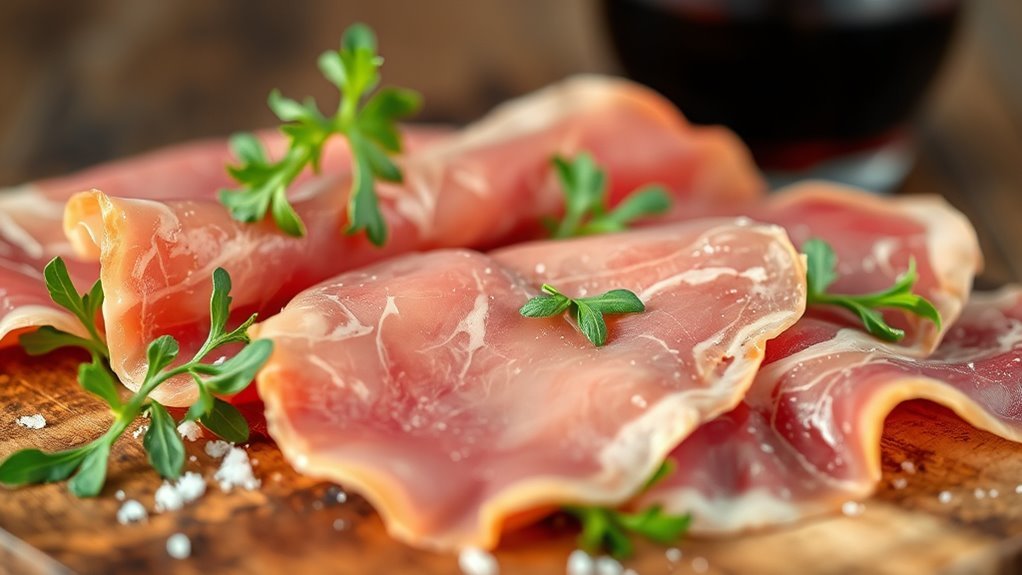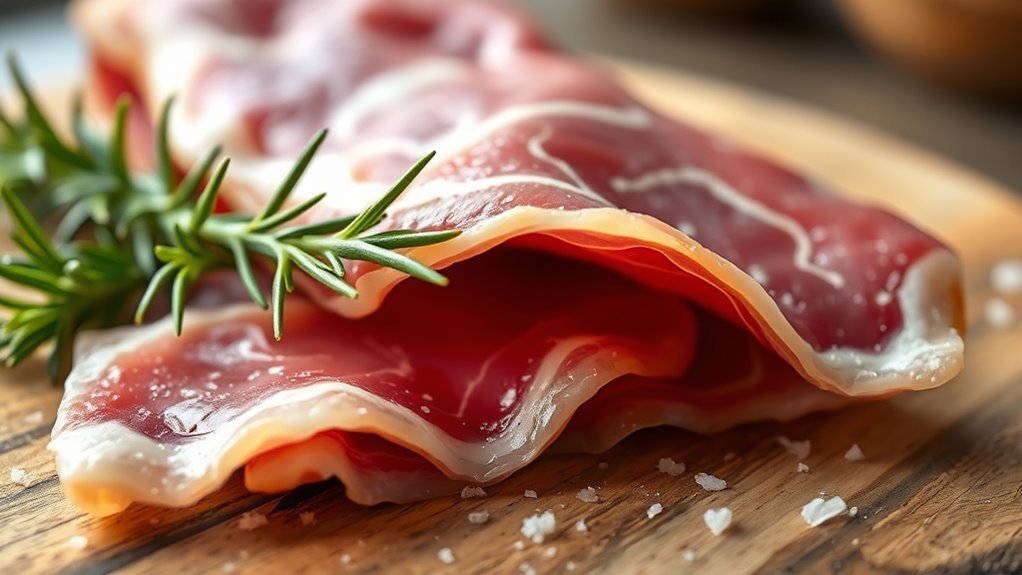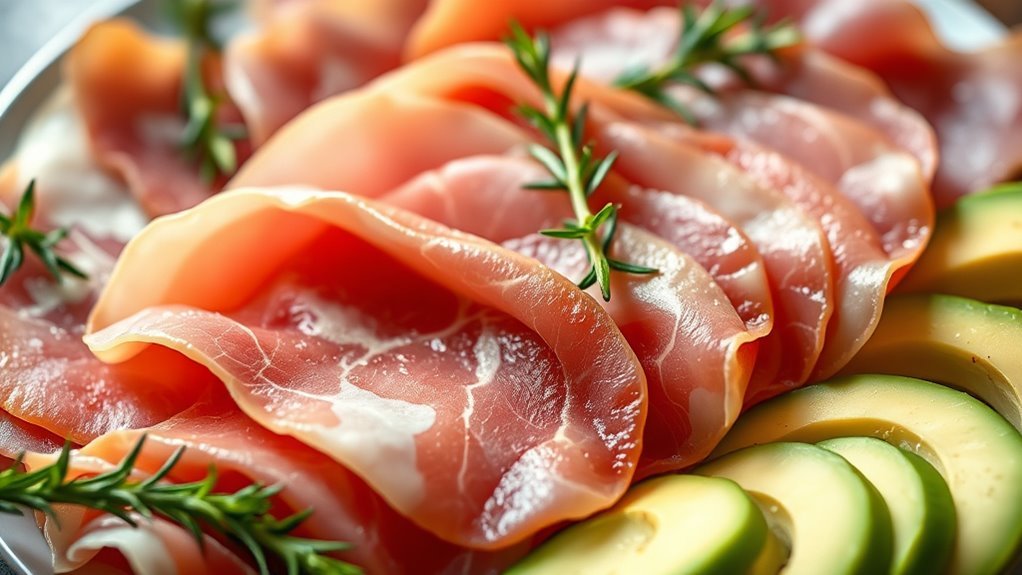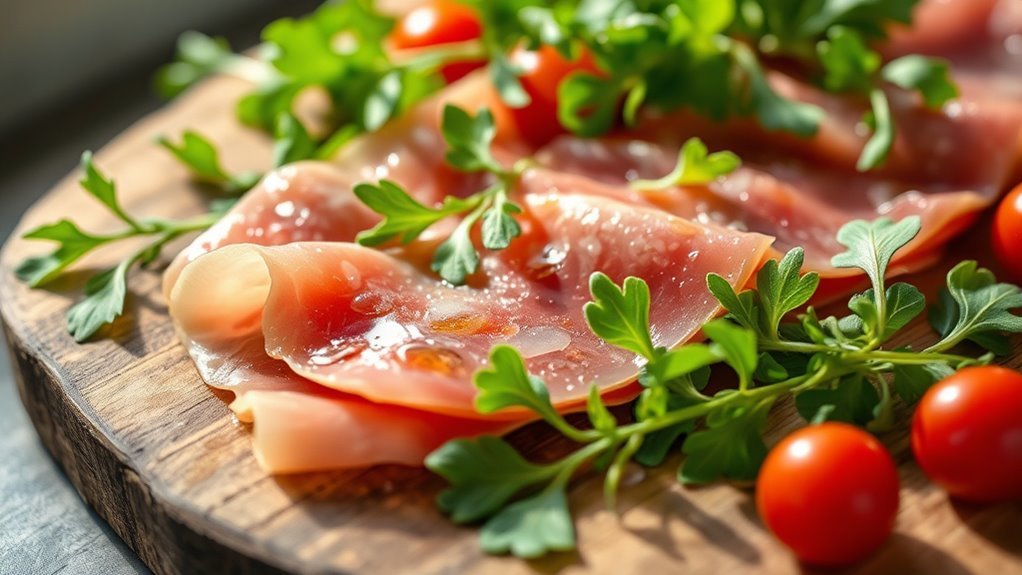Yes, prosciutto is keto-friendly! It’s low in carbohydrates, averaging just 0-1 gram per serving, making it a great option for low-carb diets. Plus, it offers high-quality protein and healthy fats, which can support energy and satiety. However, keep an eye on sodium levels and enjoy it in moderation. You can pair prosciutto with low-carb cheeses or veggies for tasty snacks. If you want tips on incorporating it into your meals, there’s more to explore!
Nutritional Profile of Prosciutto

When considering the nutritional profile of prosciutto, it’s important to recognize its unique attributes. Originating from Italy, prosciutto is made from high-quality pork, which contributes to its rich flavor and nutritional value. There are various prosciutto varieties, such as Prosciutto di Parma and Prosciutto di San Daniele, each with distinct taste and texture due to regional curing methods. Generally, prosciutto is high in protein and healthy fats while being low in carbohydrates, making it a popular choice for those following low-carb diets. However, its sodium content can be quite high, so moderation is key. By understanding prosciutto’s origins and varieties, you can make informed choices that align with your dietary preferences and lifestyle goals.
Carb Content in Prosciutto

Prosciutto contains minimal carbohydrates, typically averaging around 0-1 gram of carbs per serving. This low carb content makes it an excellent choice for those following a keto diet. Different prosciutto varieties, like Prosciutto di Parma or San Daniele, offer unique flavors without adding carbs.
Consider these serving suggestions to elevate your prosciutto experience:
- Pair it with low-carb cheeses for a delightful snack.
- Wrap around asparagus for a savory appetizer.
- Add to salads for a gourmet touch.
With such versatility and minimal carbs, prosciutto not only satisfies your taste buds but also aligns with your dietary goals. Embrace the freedom to enjoy this delicious meat without worrying about your carb intake!
Health Benefits of Prosciutto

While many cured meats may not be the healthiest options, prosciutto stands out for its unique nutritional profile, offering several health benefits. It’s a fantastic protein source, providing essential amino acids vital for muscle repair and overall health. Prosciutto also contains prosciutto vitamins, including B vitamins like B12 and B6, which support energy metabolism and brain function. Additionally, its healthy fat content can potentially benefit heart health by improving cholesterol levels when consumed in moderation. The low carbohydrate content aligns well with low-carb diets, making it an appealing choice for those looking to maintain a balanced lifestyle. Enjoying prosciutto in moderation can add flavor and nutrition to your meals while promoting a sense of freedom in your dietary choices.
How to Incorporate Prosciutto Into a Keto Diet
Incorporating prosciutto into your keto diet can be both enjoyable and versatile. You can snack on it straight, add it to salads for a protein boost, or use it in wraps and appetizers to enhance flavor without adding carbs. By exploring these options, you can easily make prosciutto a staple in your low-carb meals.
Prosciutto as Snack Option
Have you considered how versatile prosciutto can be as a snack option on a keto diet? This cured meat isn’t just delicious; it’s also low in carbs and high in flavor, making it ideal for your lifestyle. You can easily incorporate prosciutto into your snacking routine with some thoughtful pairings.
- Pair it with cheese for a satisfying treat.
- Roll it around seasonal veggies for a crunchy delight.
- Enjoy it with olives for a savory bite.
For best results, pay attention to prosciutto storage; keep it in the fridge wrapped tightly to maintain freshness. With a little creativity, you’ll find countless ways to enjoy this delectable snack while sticking to your keto goals!
Salads With Prosciutto
Prosciutto’s versatility extends beyond snacking; it’s a fantastic addition to salads that can enhance your keto meal plan. You can create delicious prosciutto salads by combining leafy greens like arugula or spinach with slices of this savory meat. Add in low-carb veggies such as cucumbers, bell peppers, or avocado for extra flavor and nutrients.
When it comes to salad dressings, opt for olive oil and vinegar-based options to keep it keto-friendly. These dressings complement prosciutto perfectly, adding richness without unnecessary carbs. You might also consider incorporating cheese, such as feta or Parmesan, for added creaminess. With these ingredients, you’ll enjoy a satisfying and nutritious salad that aligns with your keto lifestyle, all while indulging in the delightful taste of prosciutto.
Wraps and Appetizers
When you’re looking to elevate your keto meals, wraps and appetizers featuring prosciutto can be a game changer. These delicious options not only satisfy your cravings but also keep your carb count low. Here are some ideas to get you started:
- Prosciutto wraps with cream cheese and cucumber for a revitalizing bite.
- Prosciutto appetizers paired with olives and cheese for a savory platter.
- Prosciutto and melon bites for a sweet and salty contrast.
Incorporating prosciutto into your diet allows you to enjoy rich flavors while adhering to your keto lifestyle. Each option is quick to prepare, making it easy for you to indulge without guilt. Enjoy the freedom to mix and match these ingredients for endless culinary creativity!
Prosciutto vs. Other Deli Meats
When comparing prosciutto to other deli meats, it’s crucial to look at their nutritional profiles and carb content. Prosciutto is typically lower in carbs than many processed deli meats, which can be a significant factor for those following a keto diet. Understanding these differences can help you make informed choices that align with your dietary goals.
Nutritional Comparison
Although many deli meats can be part of a keto diet, prosciutto stands out due to its unique nutritional profile. With various prosciutto varieties available, you can enjoy a flavorful choice that complements your low-carb lifestyle. When comparing prosciutto to other deli meats, consider these factors:
- Higher fat content, offering satiation and energy
- Less processed than many alternatives, aligning with health considerations
- Rich in flavor, enhancing meals without extra carbs
Carb Content Analysis
While exploring the carb content of deli meats, prosciutto often emerges as a favorable option for those on a keto diet. With its low carb count, it stands out against other deli meats. Here’s a quick comparison:
| Deli Meat | Carbs (per 1 oz) |
|---|---|
| Prosciutto | 0.1 g |
| Turkey | 0.5 g |
| Salami | 0.3 g |
When considering prosciutto pairing, it works beautifully with cheese or in salads. For serving suggestions, try wrapping it around asparagus or adding it to an antipasto platter. Its rich flavor and versatility make prosciutto an excellent choice for maintaining those low carb goals without sacrificing taste. Enjoy the freedom to indulge mindfully!
Delicious Keto Recipes Featuring Prosciutto
If you’re looking to elevate your keto meals, incorporating prosciutto can add a burst of flavor and richness to your dishes. This versatile ingredient pairs beautifully with a variety of keto-friendly foods, making it perfect for gourmet dishes. Here are some delectable recipes to try:
- Prosciutto-Wrapped Asparagus: Tender asparagus spears wrapped in salty prosciutto and roasted to perfection.
- Caprese Salad with Prosciutto: Fresh mozzarella, basil, and juicy tomatoes layered with crispy prosciutto for a revitalizing twist.
- Egg and Prosciutto Breakfast Cups: Baked eggs nestled in prosciutto cups for a quick, satisfying breakfast.
These prosciutto pairings not only enhance taste but also keep your meals exciting and satisfying, allowing you to enjoy your keto journey without compromise.
Frequently Asked Questions
Is Prosciutto Gluten-Free?
Yes, prosciutto is gluten-free! It’s made from pork, typically cured with salt and sometimes spices, so you won’t find any gluten-containing ingredients in it. When considering prosciutto’s health benefits, it’s packed with protein and provides essential nutrients. Just keep in mind that moderation is key due to its sodium content. Enjoying prosciutto can be a delicious addition to your meals while keeping your dietary preferences in check.
Can Prosciutto Be Eaten Raw?
When it comes to raw consumption, you can enjoy prosciutto safely. Made from high-quality pork and carefully cured, prosciutto is designed for eating without cooking. However, make sure it’s from a reputable source and stored properly to avoid any potential health risks. With its rich flavor and delicate texture, it’s a delightful addition to salads or charcuterie boards. Just remember, quality matters, so choose wisely for the best experience!
How Should Prosciutto Be Stored?
To store prosciutto effectively, you should keep it in its original packaging until you’re ready to use it. This helps maintain its flavor and freshness. Once opened, wrap it tightly in plastic wrap or place it in an airtight container. Prosciutto has a shelf life of about three to five days in the fridge after opening. If you need longer storage, consider freezing it, though the texture may slightly change.
What Types of Prosciutto Are Available?
When exploring the types of prosciutto available, you’ll find various cured varieties, each with its unique flavor profile. The most famous is Prosciutto di Parma, known for its sweet, delicate taste. Then there’s Prosciutto di San Daniele, which has a slightly nuttier flavor. Regional differences also play a role; for instance, some areas use different aging techniques, affecting texture and taste. Whether you prefer them on a charcuterie board or in a sandwich, there’s plenty to enjoy!
Is Prosciutto High in Sodium?
Yes, prosciutto typically has a high sodium content, which can vary depending on the brand and preparation. This might raise concerns about health implications, especially if you have hypertension or heart issues. While sodium is essential in moderation, excessive intake can lead to water retention and increased blood pressure. If you enjoy prosciutto, it’s wise to balance it with low-sodium foods and monitor your overall sodium consumption for better health.


